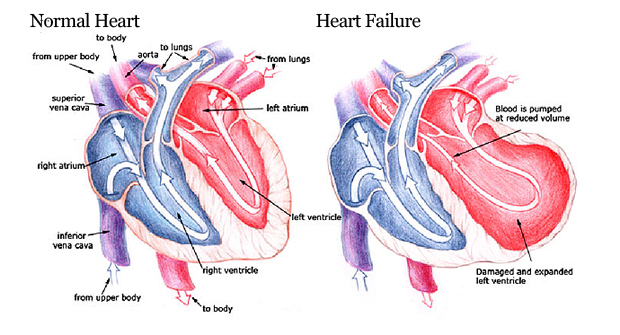


The function of the healthy heart is to pump blood continuously through the circulatory system. The pumping action delivers blood that is oxygen and nutrient rich to cells in the body. Proper nourishment to these cells is necessary for the body to function normally. Heart failure means the heart is not able to pump effectively to supply the cells with enough blood as the heart is weakened. This is considered to be a chronic and progressive condition. The following is heart failure stages with symptoms and treatment options associated with each stage. Although there is no cure, it is still possible to have good quality of life if the condition is managed appropriately.
The following picture shows the differences beteewn a normal heart and a heart suffered from heart failure. The left ventricle is damaged and expanded while the blood is pumped out of the heart at a reduced volum.

Those at stage A congestive failure are at risk of developing heart failure or pre-heart failure, including people with high blood pressure, diabetes, metabolic syndrome, coronary artery disease, history of cardiotoxic drug therapy, history of alcohol abuse, rheumatic fever or cardiomyopathy.
Treatments for Stage A:
Patients at stage B congestive failurehave heart disease related structural defects with the risk of developing heart failure, including patients with a history of a heart attack, cardiomyopathy or valve disease but no signs or symptoms of congestive heart failure. Those with an ejection fraction of less than 40% are also at risk.
Treatments for Stage B:
Patients at stage C congestive failureare diagnosed with heart failure and have current or previous symptoms which may include: difficulty breathing, Fatigue and apoor tolerance to exercise.
Treatments for Stage C:
Among heart failure stages, the last one is stage D or end stage congestive heart failure. Patients at this stageare diagnosed with heart failure and are experiencing advanced symptoms despite optimal medical care.
Below is a closer look at the symptoms associated with this late stage of disease.
Treatments for Stage D:
All treatments for above heart failure stages can be used. Besides, patients will also be evaluated by a healthcare provider to determine if treatments such as a heart transplant, ventricular assist device, other surgical options, research therapies, continuous infusion of intravenous heart medications and end of life care (hospice or palliative) are available options.
Seek Immediate Medical Care for End Stage Congestive Heart Failure
The terms heart failure and congestive heart failure are sometimes used interchangeably.When the amount of blood flow out of the heart begins to slow, blood returning to the heart via the veins begins to back up, causing congestion in the body’s tissues.
Enlarge: The heart chamber will enlarge so it can contract stronger to pump more blood. When this occurs your body begins to retain fluid, your lungs can become congested with fluid and the heart will begin to beat irregularly.
Increase muscle mass: The contracting cells of the heart get bigger, thus increasing the muscle mass. Initially, this allows the heart to pump more strongly and faster to increase its output.
Other methods of compensation:
These temporary methods of compensation only mask heart failure, not solve it. The heart failure continues and worsens until these methods are no longer effective.
With congestive heart failure, you may experience the following symptoms:
Your healthcare provider can do a thorough assessment and necessary testing to determine if a diagnosis of heart failure is to be made. Based on these results, you will be associated with a particular congestive heart failure stage and treated accordingly.